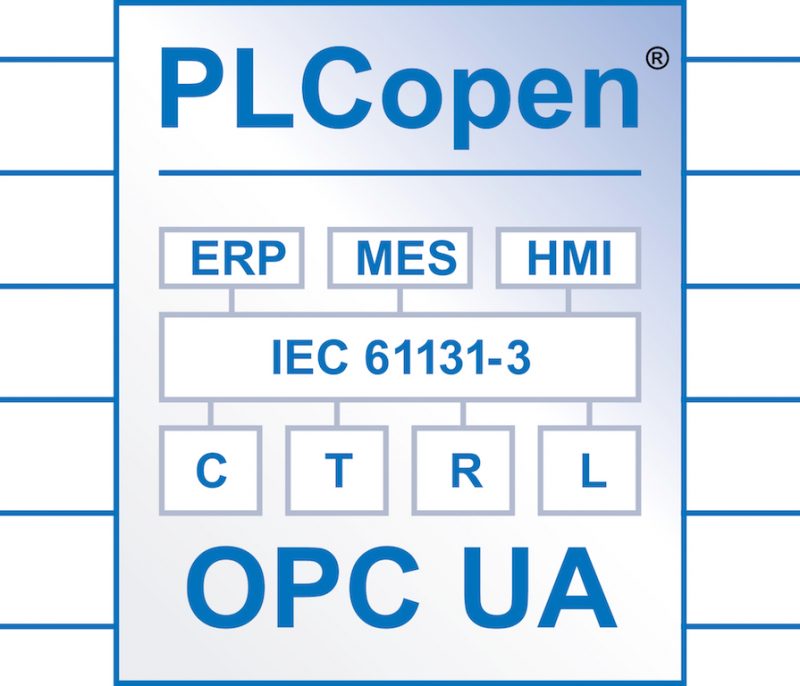The OPC Foundation, in collaboration with PLCopen, announced the release of v1.02 of the “OPC UA for IEC61131-3” specification. Building on the first version of the specification, the Joint Working Group added:
- support for all datatypes defined in the 3rd edition of IEC61131-3
- an optimized, machine-readable version of the information model (i.e. nodesetfile)
- compliance with enhanced specification templates to support the tool chain used to generate validated information models
- inclusion in the global online searchable specification reference at https://reference.opcfoundation.org
- OPC Foundation Compliance Test Tool (CTT) test cases for validation of vendor implementations of “OPC UA for IEC61131-3”
 Founded in 2008, this joint working group has the goal of expressing IEC 61131-3 information models using OPC UA. By doing so, an IEC6-61131-3 PLC project that is loaded onto different control platforms can be displayed in a standardized form and made available for communication via the controllers’ OPC UA servers.
Founded in 2008, this joint working group has the goal of expressing IEC 61131-3 information models using OPC UA. By doing so, an IEC6-61131-3 PLC project that is loaded onto different control platforms can be displayed in a standardized form and made available for communication via the controllers’ OPC UA servers.
 “This first step harmonizes the access of the project running in the controller” says Eelco van der Wal, Managing Director of the PLCopen organization. “With this an unprecedented transparency is created in the communication in industrial automation, enabling the configuration of the communication much faster and independent of the network and suppliers. For this reason, many suppliers have implemented this, providing their users with the ease of use in communication.”
“This first step harmonizes the access of the project running in the controller” says Eelco van der Wal, Managing Director of the PLCopen organization. “With this an unprecedented transparency is created in the communication in industrial automation, enabling the configuration of the communication much faster and independent of the network and suppliers. For this reason, many suppliers have implemented this, providing their users with the ease of use in communication.”
Major PLC Vendors Implemented “IEC61131-3 as UA Client”
In addition to the server specification “UA for IEC61131-3” the group also worked very successfully on the “client specification” which was originally released in 2014. The implementation of this functionality on a controller makes it possible to initiate a communication session to any other available OPC UA Server. The controller can exchange complex data structures horizontally with other controllers independent of the fieldbus system used, or vertically with other devices using an OPC UA server service oriented architecture, like an MES/ERP system in order to collect data or write new production orders to the cloud.
 Stefan Hoppe, the President and Executive Director of the OPC Foundation first initiated the idea of PLCopen Function Blocks during the first OPC UA developer conference back in October 2006 when he was a Product Manager of TwinCAT at Beckhoff. Mr. Hoppe commented “I am proud that this specification has been implemented by the world’s leading PLC manufacturers such as 3S, BECKHOFF, Bosch-Rexroth, B&R, Honeywell, Omron, Phoenix Contact, and Siemens and is used in many international applications. For example, these function blocks were used by Honeywell for the implementation of the MDIS specification in the oil & gas market. These function blocks have been combined and nested to provide higher quality solutions tailored to the MDIS application, and so making it easier for the customer to use.
Stefan Hoppe, the President and Executive Director of the OPC Foundation first initiated the idea of PLCopen Function Blocks during the first OPC UA developer conference back in October 2006 when he was a Product Manager of TwinCAT at Beckhoff. Mr. Hoppe commented “I am proud that this specification has been implemented by the world’s leading PLC manufacturers such as 3S, BECKHOFF, Bosch-Rexroth, B&R, Honeywell, Omron, Phoenix Contact, and Siemens and is used in many international applications. For example, these function blocks were used by Honeywell for the implementation of the MDIS specification in the oil & gas market. These function blocks have been combined and nested to provide higher quality solutions tailored to the MDIS application, and so making it easier for the customer to use.